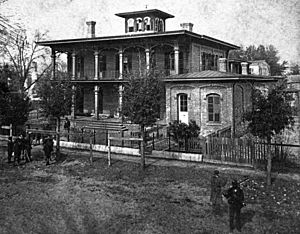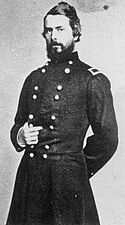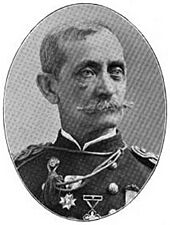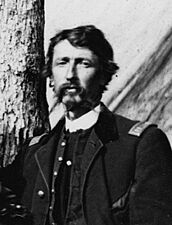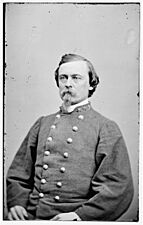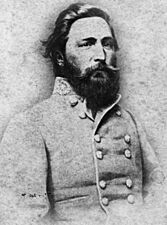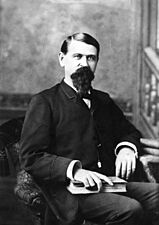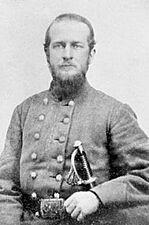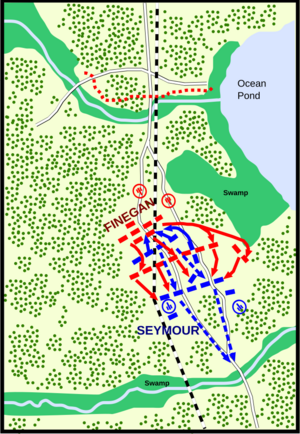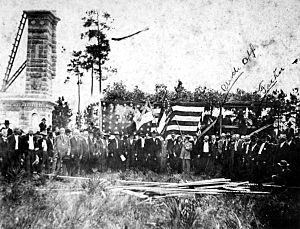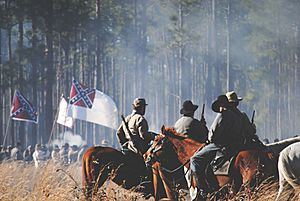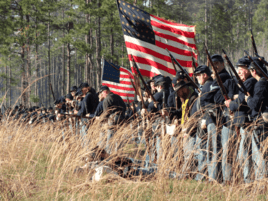Battle of Olustee facts for kids
Quick facts for kids Battle of Olustee |
|||||||
|---|---|---|---|---|---|---|---|
| Part of the American Civil War | |||||||
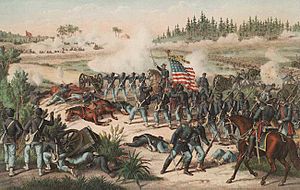 Battle of Olustee, by Kurz and Allison, 1894 |
|||||||
|
|||||||
| Belligerents | |||||||
| Commanders and leaders | |||||||
| Truman Seymour | Joseph Finegan | ||||||
| Units involved | |||||||
| District of Florida | District of East Florida | ||||||
| Strength | |||||||
| 5,500 | 5,000 | ||||||
| Casualties and losses | |||||||
| 1,861 (203 killed 1,152 wounded 506 captured/missing) |
946 (93 killed 847 wounded 6 captured/missing) |
||||||
The Battle of Olustee was a major fight during the American Civil War. It happened in Baker County, Florida, on February 20, 1864. This battle was the largest one fought in Florida during the entire war.
Union General Truman Seymour brought his troops to Jacksonville. His main goal was to stop the Confederates from getting food supplies. He faced little resistance at first. Then, he decided to march towards Tallahassee, Florida's capital. He did this even though he was told not to go so deep into the state. He thought he would only meet small local forces.
But, Confederate soldiers from Charleston, South Carolina, arrived to help. General Alfred H. Colquitt led these extra troops. The two armies met near Ocean Pond in Olustee. The Union forces were pushed back and had to retreat to Jacksonville. Some Union soldiers stayed there to hold the area. Others were sent to different places where they were needed more.
Contents
Why Did the Battle of Olustee Happen?
In February 1864, Major General Quincy Adams Gillmore was a Union commander. He was based at Hilton Head, South Carolina. General Gillmore ordered his troops to go into Florida. He had a few reasons for this mission.
First, he wanted to protect areas in Florida that the Union already controlled. Second, he aimed to cut off important supply routes for the Confederates. These routes were used to get beef and salt. Third, he wanted to recruit African American soldiers for the Union army.
Brigadier General Truman Seymour was in charge of this mission. His troops landed in Jacksonville. The Union had already taken control of this area in 1862. Seymour's forces went on several raids in northeast and north-central Florida. They didn't face much resistance during these raids. They captured Confederate camps, small groups of soldiers, and cannons. They also helped enslaved people gain their freedom.
However, General Seymour had strict orders from Gillmore. He was not supposed to go too far into Florida.
How Did the Confederates Respond?
The Confederates in Charleston, South Carolina, were worried about Seymour's actions. General P. G. T. Beauregard correctly guessed that Seymour's target was Florida. He thought the Union actions were a big enough threat. So, he sent more soldiers to Florida. These reinforcements were led by General Alfred H. Colquitt from Georgia.
Colquitt's troops arrived just in time to help the Florida soldiers. These Florida troops were under the command of Brigadier General Joseph Finegan. As Colquitt's soldiers started to arrive, General Seymour made a decision. Without General Gillmore knowing, Seymour began a new push across north Florida. He might have even planned to capture Tallahassee.
Who Fought at Olustee?
Union Forces
The Union army at Olustee had about 5,500 soldiers. They were led by Brigadier General Truman Seymour.
-
Brig. Gen.
Truman Seymour, USA -
Col.
James Montgomery, USA -
Col.
Guy Vernor Henry, USA
Confederate Forces
The Confederate army had about 5,000 soldiers. They were led by Brigadier General Joseph Finegan. They also had reinforcements under Brigadier General Alfred H. Colquitt.
-
Col.
George Paul Harrison, Jr., CSA
What Happened During the Battle?
General Seymour led his 5,500 Union soldiers along the Florida, Atlantic and Gulf Central Railroad. They were heading towards Lake City. Around 2:30 in the afternoon on February 20, the Union forces got close to General Finegan's 5,000 Confederates. The Confederates were dug in near Olustee Station.
Finegan sent out a group of soldiers to meet Seymour's leading units. He wanted to trick the Union soldiers into coming closer to his dug-in positions. But this plan did not work out. The two armies met at Ocean Pond, and the battle began.
Seymour made a big mistake. He thought he was fighting only the small Florida militia units again. He had easily beaten them before. So, he sent his troops into the battle bit by bit, instead of all at once. Both Finegan and Seymour sent more soldiers to help their fighting units throughout the afternoon. The battle took place in open pine woods. The Union forces attacked, but they were met with strong rifle and cannon fire. They were pushed back hard.
The fighting continued all afternoon. Finally, General Finegan sent in his last reserve soldiers. At that point, the Union line broke apart. The Union soldiers began to retreat. Finegan did not chase them very hard. This allowed most of the fleeing Union forces to reach Jacksonville.
The Confederates did try one last attack on the Union's rear guard. This happened just before nightfall. But soldiers from the 54th Massachusetts Volunteer Infantry Regiment and the 35th United States Colored Troops stopped them. Both of these units were made up of Black soldiers.
What Happened After the Battle?
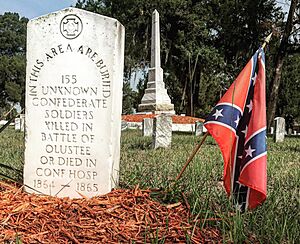
The Union army suffered many losses. They had 203 soldiers killed, 1,152 wounded, and 506 missing. This was a total of 1,861 men. That's about 34% of their forces. The Confederate losses were lower. They had 93 killed, 847 wounded, and 6 missing. This was a total of 946 casualties, about 19% of their forces. The Union also lost six cannons and 39 horses, which were captured.
This battle was very bloody for the Union. About 265 Union soldiers were killed or wounded for every 1,000 troops. Soldiers on both sides had fought in other big battles. But many of them wrote in letters and diaries that this was some of the worst fighting they had ever seen. The Confederate soldiers who died were buried at Oaklawn Cemetery in nearby Lake City.
The heavy Union losses made leaders in the North wonder. They questioned if it was worth sending more troops to Florida. Florida was not a very important state for the war's overall outcome.
On February 22, the Union forces were still retreating to Jacksonville. The 54th Massachusetts was ordered to go back to Ten-Mile Station. A train carrying wounded Union soldiers had broken down. These wounded soldiers were in danger of being captured. When the 54th Massachusetts arrived, the men used ropes to pull the train. They pulled it about three miles to Camp Finegan. There, they found horses to help pull the train. After that, both men and horses pulled the train to Jacksonville. This was a total distance of 10 miles (16 km). It took 42 hours to pull the train that far.
In the South, the battle was seen as a great victory. It boosted their spirits. One newspaper in Georgia joked about the Union forces. It said they walked "forty miles over the most barren land of the South... and getting a terrible thrashing."
Olustee Battlefield Today
Today, the battlefield is a special place. It is called the Olustee Battlefield Historic State Park. This park is part of Florida's state park system. It is located inside the Osceola National Forest, on U.S. 90. Part of the battlefield is a state park, and part is in the national forest. Some of the land on the south side of U.S. 90 is privately owned.
Nearby Lake City hosts a yearly event. It's called the Lake City, Florida#Olustee Battle Festival. This festival has been held since 1976.
Every February, on Presidents' Day weekend, a special event takes place. It is an annual historical reenactment of the battle. Thousands of people from all over the U.S. and even other countries come to participate. They dress up as soldiers from the Civil War.
Some reenactors arrive as early as Thursday to set up their camps. Friday is "School Day." Hundreds of students visit to watch demonstrations. They also listen to historians talk about the war and life in the 1860s. The event is open to the public from Friday through Sunday. There are many "sutler tents" where you can buy Civil War-themed items. The reenacted battles happen on Saturday and Sunday. You can also buy modern food inside the park from Friday to Sunday.
Four groups work together to put on the Battle of Olustee reenactment. These are: the Olustee Battlefield Historic State Park Citizens Support Organization; the Florida Department of Environmental Protection – Recreation and Parks; the USDA Forest Service – Osceola National Forest; and The Blue-Grey Army, Inc.
About the Battle Lithograph
The picture at the very top of this page is a lithograph. It was made by a company called Kurz and Allison in 1894. It shows soldiers from the 8th U.S. Colored Troops moving forward against Confederate trenches.
This image is often used when talking about the Battle of Olustee. However, it is not completely accurate. It shows that the artist didn't know exactly what happened. During the real battle, the Confederates fought far away from their prepared positions. Neither side fought from behind strong walls or trenches. The fighting happened in a pine forest. There were not many large open areas. The dotted red line on the map shows where the Confederate trenches were.
See also
 In Spanish: Batalla de Olustee para niños
In Spanish: Batalla de Olustee para niños


